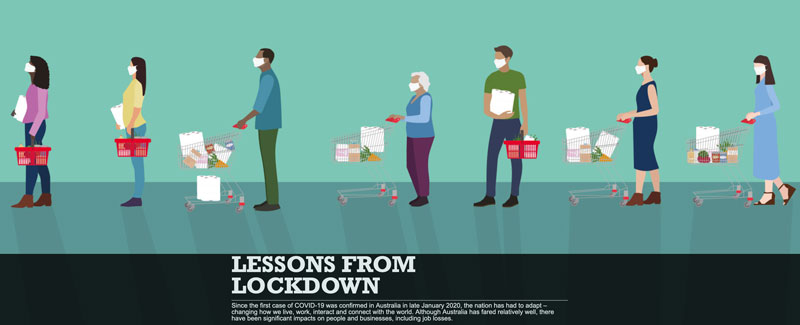Article Lead In
12 December 2022
AUTHOR: ANNABEL MANSFIELD
More than two years after the COVID-19 pandemic began, the effects are still being felt across society. We asked University of South Australia experts from a range of fields to share their insights.
-
Two and a half years into the pandemic, what have we learnt?
By Professor of Biostatistics Adrian Esterman

Earlier this year, Australia made the divisive decision to end mandatory COVID-19 isolation. Embraced by some, but adamantly rejected by others, the move delivers increased public freedom, but also unequivocally increased risk, particularly as we move toward the busy Christmas season and a fresh wave of the virus. It poses the question: have we really learnt anything about public health?
The virus
The SARS-CoV-2 will keep mutating. Since the original Omicron variant in late 2021, there are now more than 300 subvariants of Omicron, many more infectious and immune resistant than BA.5, the subvariant that caused the most recent wave. Many of these new subvariants have similar mutations and appear to be converging. There are two families of Omicron taking over from BA.5 in Asia, Europe and the USA. BQ.1 is a descendant of BA.5, and now accounts for more than 7 per cent of genomic sequences in Australia. XBB is a combination of BA.2.75 and BJ.1; it is rapidly gaining ground in much of Asia and is already in Australia. A rise in cases is likely as waning immunity, the removal of mandatory isolation, and new and more transmissible subvariants are likely to spread quickly.
Vaccines
While about 95 per cent of the population has had two vaccine doses, this now provides almost no protection against infection, and only some protection against serious illness and death.
Staying protected is paramount. Current vaccines have been highly successful at preventing serious illness and death, but these new subvariants can increasingly evade protection from either natural immunity (caused by infection and recovery) or vaccine-induced immunity. Booster shots help, but sadly, only about 70 per cent of people have had a booster, leaving millions of people with little protection. At least we now have the new Moderna bivalent booster available in Australia, which provides better protection than the original Moderna vaccine.
Masks
Now that isolation restrictions have lifted, protecting ourselves is even more important. And while masks work, simply mandating people to wear a face mask isn’t sufficient; the government needs to explain the different masks, as well as when and how to wear them. Cloth masks provide little protection, surgical masks are better, but the KN95/P2/N95 masks are best. And if you’re wearing a mask under your nose, you might as well forget it.
Hygiene
As COVID-19 is primarily an airborne disease, good ventilation is critical to preventing infection. Doing a ventilation audit of your workspace, improving air flow, and installing air purifiers are all good preventative steps. Hand hygiene is important too, but recent research found that only 0.01 per cent of infections are picked up by touching contaminated surfaces, so this isn’t a major issue. Having said that, hand hygiene can prevent other illnesses such as gastrointestinal viruses.
Reinfection and long COVID
Long COVID affects 10-15 per cent of all infected people and can devastate your body, including your mental health.
Because of these subvariants’ ability to escape our immune system, many people are getting infected multiple times. And while a reinfection may be milder, each increases your chance of long COVID. The best way to avoid long COVID is clearly not to get infected.
-
People are making positive changes amid the pandemic
By Senior Lecturer Dr Silvia Pignata.

Throughout the pandemic, Australians have adhered to strict government-imposed lockdowns, mask mandates, workplace restrictions and social distancing requirements. Cautioned by health experts, and driven by fear and empathy, we put our holidays on hold, endured delayed ‘elective’ surgeries, and isolated according to the law and community pressure.
Now, with new antiviral drugs, high vaccination levels and isolation rules removed, the requirement to keep safe comes down to the individual.
Such a return to (near) pre-COVID-19 normalcy means the community will again have the freedom to decide how to run their lives. But while some will find this reassuring, others will feel anxious about the public’s willingness to adhere to precautions, without stipulated mandates.
The post-pandemic ideal is for the public to build a sense of self-care and capacity for their own health decisions, which includes staying home when sick to reduce the spread of COVID-19 and other viruses at work and within the community. And, while there may be some scepticism as to whether the community can achieve this, it’s important to remember that the pandemic has delivered some positive outcomes, particularly for workplaces and work culture.
People’s resilience and capacity to learn from the pandemic has been demonstrated in several ways. Firstly, people started reflecting on what was most important to them, resulting in many leaving or changing jobs (the ‘Great Resignation’); secondly, people proved they could work productively and sustainably away from the physical office (which led to the blended or ‘hybrid’ work concept); and thirdly, people drew boundaries between their work and personal lives, to better ensure a positive work-life balance and better wellbeing.
Let’s hope we can maintain these changes as we move forward.
-
Vulnerable people are still at risk
By Associate Professor of Sociology in Education Elspeth McInnes AM

Amid social isolation, vulnerable people always experience extra layers of risk. And no more so than children and adults who require health, disability or developmental supports, many of which are currently in short supply. Going without needed supports can create additional health risks, and children can 'time out' of the developmental stage when those supports can have the greatest benefit.
Parents and carers of people with health and disability needs also face extra strain when the people they care for cannot access the supports they need. And, while many may try to fill the gaps, they don’t have the required resources or expertise to deliver, ending up more stressed themselves.
The combination of increased demand, increased stress and less support is a contributor to growing rates of child maltreatment and family and domestic violence.
Targets of violence and abuse can be trapped in the home without any connections to daycare, schools and workplaces. Additionally, families that are part of the casual, low-paid workforce are particularly vulnerable as their finances fluctuate, and they don’t have the safety net of paid sick leave.
Many health, social and education services have responded by supplementing in-person services with online access, but this approach is limited by the need for physical care provision and the ‘digital divide’, where not all households have internet connectivity, or devices which they can easily use to learn and connect. Developing strategies to reduce this divide and to ensure that access to social services and supports can continue, despite the pandemic limits, is an ongoing project.
We must all be alert to opportunities that amplify the voices of families grappling with vulnerable circumstances and work hard to limit the adverse impacts of pandemic-induced isolation.
-
Managing healthcare in a (broken) system
By lecturer in Nursing and Health Services Management Dr Matylda Howard

As a direct result of COVID-19, healthcare managers are clearly under more pressure than ever. Long hours, unrealistic expectations and workforce issues have aggravated existing concerns and our healthcare system is feeling the brunt.
In one of our recent studies, healthcare managers told us that they were struggling with excessive workloads, competing demands and the inability to delegate tasks because of a lack of staff. Add to this the constant changes to regulations and restrictions that managers must be aware of, as well as ongoing criticisms about the aged care sector, and it’s no surprise that their morale and energy levels are suffering.
We can all be a bit more empathetic and a little less critical.
Managing energy and stress levels for staff within the health sector is paramount. Healthcare managers are acutely aware of the need to destress and re-energise. At home, they’ve told us that exercising regularly, spending time with family and friends and caring for a pet all helped manage their work-related tiredness. And at work, their stress management strategies include trying to plan activities ahead of time to help feel more in control, debriefing with someone they trusted when they felt overwhelmed and, where possible, having flexible working arrangements to help regulate their emotional wellbeing and energy levels.
There’s no doubt that healthcare leaders need energy-improving strategies to help them manage the challenges of working within a stretched healthcare system.
-
An increased focus on mental health
By Chair: Mental Health Nursing Professor Nicholas Procter

Across Australia, it’s been another year of transition. The ongoing impact of the COVID-19 pandemic must be seen in the context of Australia entering another potential bushfire season, the aftermath of natural disasters and emerging cost of living pressures.
Coming out of pandemic, mixed results arising from scale surveys indicate that, for some young Australians, mental health, wellbeing and overall life satisfaction may have improved favourably. Elsewhere, national data indicate there has been a substantial increase in rates of self-harm for young people aged up to 24 years, and particularly pronounced for young females.
More promising is that in high-income and upper-middle-income countries, lives lost to suicide have remained largely unchanged or declined compared with the expected levels based on the pre-pandemic period. While this is also encouraging, experts in the area are reinforcing the message to governments, clinicians, policy makers and service leaders that it’s important to not take our eye off the ball.
Drivers of distress can fluctuate, and people can feel that they need help at any time.
Focused attention must be given to drivers of distress. Income support to ease cost of living pressures can also go a long way to support people. The way that communities connect, relate to each other and rally around individuals is also important. We also need to remain vigilant and informed by good quality data – preferably real time data – to respond if the situation changes as the longer-term mental health and economic effects of the pandemic unfold.
Recent findings on the mental health impacts of long COVID suggest that the heightened risk of mental ill health is subsiding. The rates of depression and anxiety among people who had COVID were no different from those who had other respiratory infections within a couple of months, and there was no overall excess of these conditions over two years.
One of the positives coming out of COVID-19 is the increased focus on workplace mental health.
Proactively supporting people at work and providing improved services and digital tools that meet the needs of people wherever they are, is a positive outcome from the pandemic.
The challenge is to design and implement what we know to be effective, so we can best help people. The key point is to work together alongside individuals with lived experience of mental distress to implement tools, services and public policy to mitigate risk and help prevent crisis associated with these pressures.
Professor Nicholas Procter is also Director: Mental Health and Suicide Prevention Research and Education Group
-
The new employment relationship
By Research Professor in Human Resource Management Carol T. Kulik

The Great Resignation … quiet quitting (and even quiet firing) … these shorthand labels reflect a dramatic renegotiation of the employment relationship that is redefining not just where, but how we work.
Having tasted remote work during the COVID-19 pandemic, many employees now insist they will never give it up; they’re even willing to sacrifice pay to avoid the office commute. And while some employers say that employees can ‘work anywhere’, most insist that employees spend at least some time in the office.
Some companies are drifting toward a hybrid compromise where employees spend about three days in the office and two days working remotely. But compromises never deliver win-win solutions, and in this case, employees, employers and society might want to be careful what they wish for.
While many employees enjoyed unprecedented levels of autonomy while working remotely, any ‘new’ remote arrangements are likely to be accompanied by higher levels of employer monitoring and surveillance. In fact, a rethink of performance management – from time-oriented to results-oriented – will be needed before employers truly embrace remote work as flexible work.
If fewer employees are physically in the office, there are fewer opportunities for informal learning and cross-generational knowledge transfer. For example, think of the junior clerk who drafts a legal brief, then watches as the senior partner edits it. Unless these watch-and-learn opportunities are mindfully built into a hybrid model, employees’ skills will stagnate and – eventually – diminish the quality of work delivered to clients.
As a society, we all need to reflect on the impact that a hybrid model will have on diversity and inclusion.
Women in Australia still carry the largest burden of caring responsibilities, and are more likely to opt for remote work, even if it means sacrificing pay or changing employers.
Unfortunately, when women are ‘out of sight’ they can also be ‘out of mind’, so gender-skewed remote work may widen gender gaps in pay, professional development and career advancement.
-
Office space, post pandemic
By Creative Industries and Interior Architecture program director Andrew Wallace

As a workplace designer and interior design professional and academic, speculation about office design has always been a topic of discussion. From decentralisation to telecommuting, the evolution of office space continues to be top of mind. But in the depths of the 2020 lockdown, the one question that was often floated was “Is the office dead?”.
Two years on, it’s clear that this is not the case. Around Australia, workers are returning to offices – at least on a part-time basis – but despite the steady recall, most businesses do not expect in-office staffing levels to return to pre-pandemic levels.
This is not only a pivotal moment for office workers and their workplaces, but also for our cities. In Adelaide, for example, there has been an overreliance on office workers to boost small city-based businesses, raising fundamental questions about the future of the city and in particular, the business activity at street level.
In terms of office space, the uptake of working from home significantly advanced hybrid ways of working and hybrid design challenges, including the need for technologies that enable remote work, how to boost worker wellbeing amid isolation, and how to maintain a working culture that is underpinned by trust.
Today, the home office provides a highly valued and focused space for individual work.
But a more distributed workforce can mean new challenges for team building and culture. Many companies are now using their centralised facilities as vehicles for galvanising culture, with the office being a place to connect with teammates.
We must also remember that younger workers also need mentoring, which can only arise through continuous face-to-face observation and interaction. And many workers (me included) deeply value the social connectedness of workplaces, and struggle with work being located at the home as it suggests that you are ‘always on’. Then again, employees who have families value flexible working arrangements and being physically nearer to schools and childcare. So, clearly, it’s not a one-size-fits-all, and the needs of individuals cannot be underestimated or ignored.
A good workplace remains a good way of attracting and retaining talent, but it is important to underscore that there is no one way of creating a workplace environment, and that good workplaces are borne out of a careful partnership between design, management and the workers themselves.
-
Education post COVID-19
By digital technology education lecturer Dr Melissa Bond

The rapid shift to emergency remote education as a result of the pandemic was a steep learning curve for teachers, school leaders, families and students alike. Yet, this widespread pivot to online and blended-learning models has provided an impetus to reimagine education, and to place greater emphasis on supporting teachers and developing innovative approaches with digital technologies.
Amid the pandemic, the opportunity to embrace technology and deploy innovative teaching and learning techniques has strengthened parent-teacher-student relationships.
Schools that were able to embrace technology – both existing and installed during lockdowns – are now ahead of the game, and can refine their remote, blended and online learning strategies. Of note are Learning Management Systems – systems that offer collaborative tools, real-time conversations, and cooperative teamwork opportunities for students and teachers.
The ability to connect through technology – whether it be through discussion boards, ePortfolios or simply Zoom or Microsoft Teams – was extremely valuable, especially in lockdown when staying connected with peers and learning was at risk. Schools that have continued to invest in technologies that support the ongoing use of hybrid and blended approaches are now better placed to support student learning, irrespective of whether students are at school or at home in the future.
Importantly, technologies not only boosted students’ social and affective engagement and learning outcomes in some cases, but also generated greater parent connection, access and visibility of learning, especially for families with primary school students. Virtual parent/teacher evenings allowed greater access for parents, and online training sessions educated them about the technologies that their children used in the classroom. Parents who can grasp the technologies that their children use are more likely be involved in their child’s learning. When parents are engaged, so too are their children.
-
The housing market after COVID
By UniSA Business Executive Dean Professor Andrew Beer

The pandemic has shaken up Australia’s housing market in ways no one expected – prices have soared when widespread falls were predicted, regional markets have grown when people were expected to stay put, and supply chains have gone haywire. What’s going on and where is the market going next?
When it comes to Australia’s housing market, there are four key lessons to consider:
- Housing remains a very attractive, safe investment. Owning a home has long been the ‘great Australian dream’, but more recently this has extended to owning investment properties; when times get tough, Australians continue to invest in housing. While some forecast that prices may fall, any change will be gradual and incremental, and likely lost in the wider ‘noise’ of inflation.
- Working from home means some regional centres will boom. A side-effect of working from home means businesses will find it near-impossible to insist on physical attendance in the workplace. As a result, regional Australia is becoming more attractive, offering affordable housing and a less crowded lifestyle. And while regional housing is likely to remain strong for the foreseeable future, governments will still need to ensure that there is enough housing for everyone.
- Housing supply chains are a vulnerable disruption. Building a house is now a complex, technology-dependent process, bottle-necked by labour shortages, backups at jammed ports and broken ‘just-in-time’ practices. A cavalier ‘she’ll be right mate’ attitude to planning is no longer good enough, and the government needs to move faster to secure new housing supplies.
- Housing insecurity leaves many in the cold. Over the past five years, more and more Australians have fallen into homelessness or housing insecurity. Too many now pay 50 per cent or more of their income for their housing, which means that they go with without food, medicines and opportunities for their children. COVID has brought this emerging crisis to a head and innovation, investment and better government processes must be actioned to ensure all Australians have a safe and secure roof over their head.
-
What the best SMEs do to thrive during hard times
By Playford Professor of Business Growth Ryan Williams

As we emerge from the long shadows of COVID, it can be seductive for businesses, particularly small-to-medium enterprises (SMEs), to become risk averse, stay their course and not push for growth. But while turbulence creates complexity, it also creates opportunity – and agile and innovative SMEs are often best positioned to take advantage of shifting markets. But how?
- The first step is to have a clear identity and a considered pathway to growth. Do you want to grow through customer recruitment or company acquisition? Is it time to open in a new territory where a competitor is failing? Knowing the essence of who you are as a company and being clear about how you will grow will help inform major decisions.
- The next step is about opportunity. Great SMEs are attuned to mitigating risk; this is key to good governance and especially important in economic downturns. But beyond a risk register, it’s equally important to keep an opportunity register. By maintaining a list of options that could grow your business – and indicators that signal action – SMEs can recognise and act quickly on opportunities.
- Understanding your capital requirements is essential. As cash is the gateway to growth, ensuring your banker or equity partner understands your business, cash flow and any potential risks and opportunities on the horizon, will save time when you need capital fast. Plus, if you’ve done the groundwork with your partner, the funding process is likely to be smoother.
- Finally, don’t forget your marketing. When times get tough, there’s a tendency to cut discretionary spending – especially marketing – which is a mistake as marketing drives both revenue and capital conversations. Plus, if your competitors cut their marketing, you’ll be in prime position to step right in; more customers mean more revenue, cashflow and a higher chance of being able to action things on your opportunities register.
Certainly, stormy times are ahead for many Australian businesses. But SMEs can use these circumstances, their agility and their innovativeness to create real advantage and longitudinal benefits for their companies.
Ryan Williams is also director of the Australian Centre for Business Growth.
In the first year of the pandemic, UniSA experts reflected on what we should learn from COVID-19. See what's changed by reading the enterprise story from 2020:
You can republish this article for free, online or in print, under a Creative Commons licence, provided you follow our guidelines.



